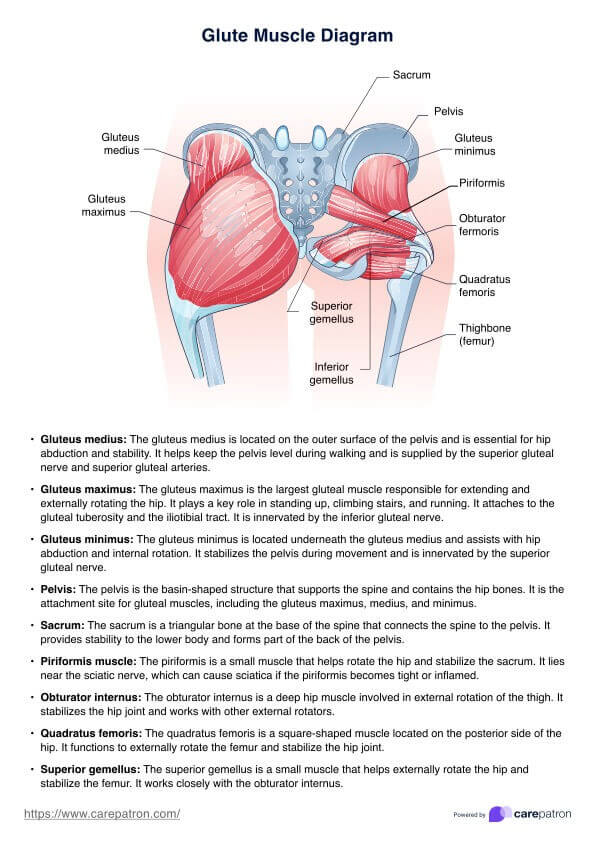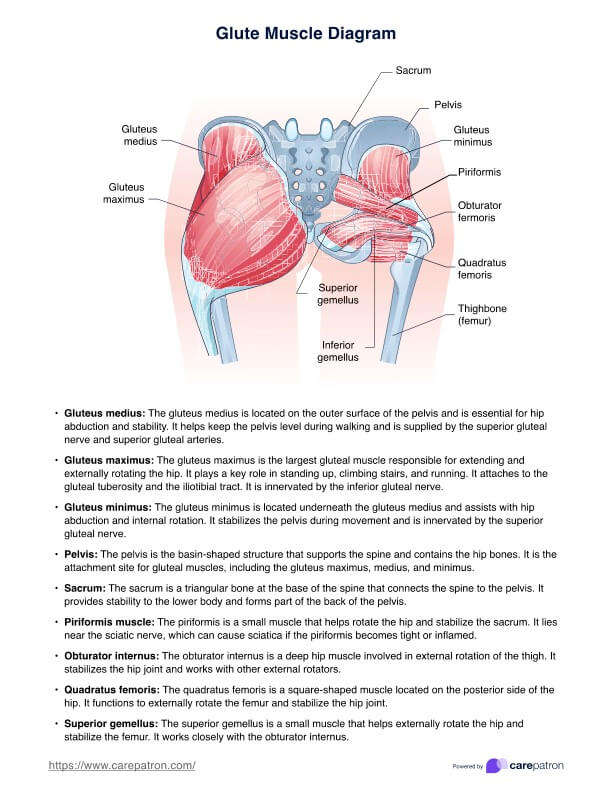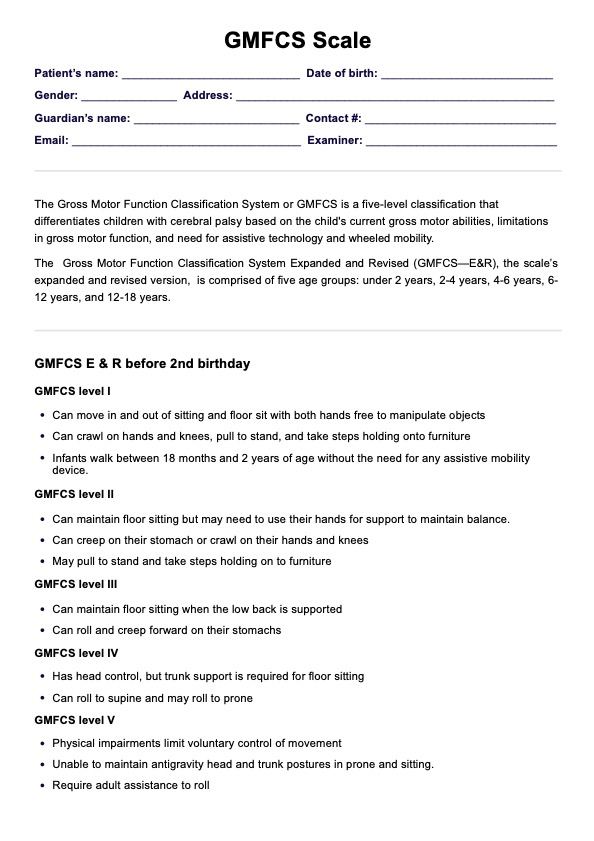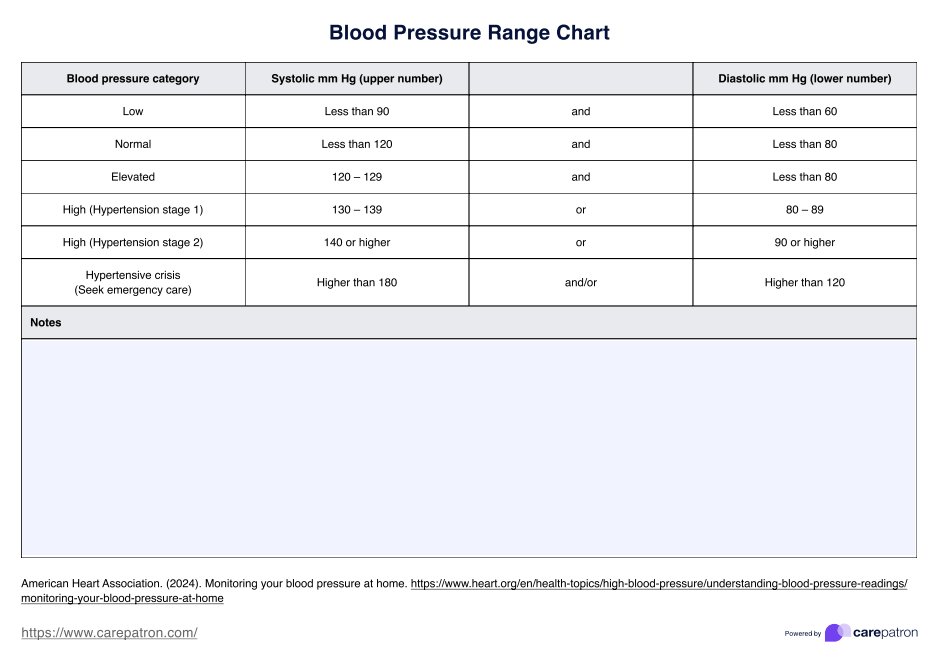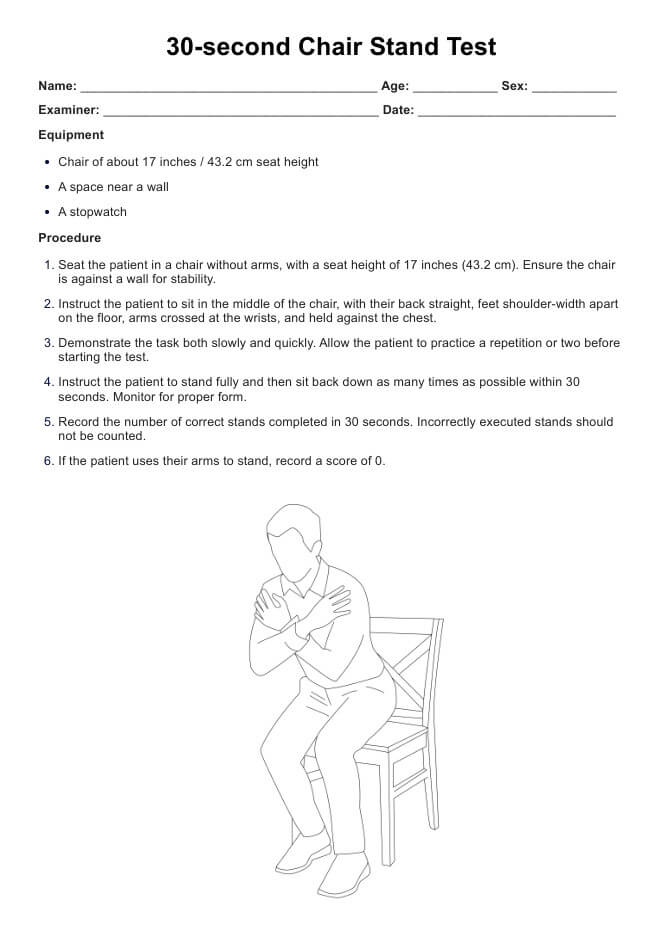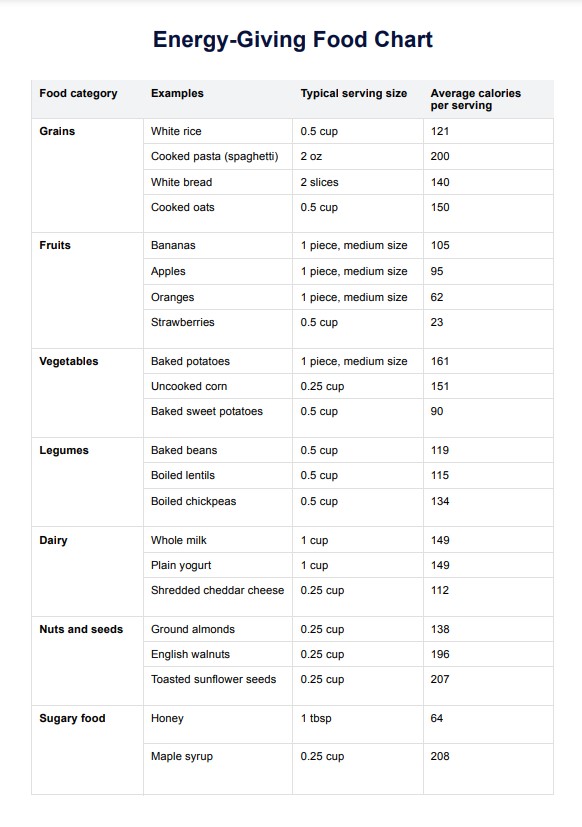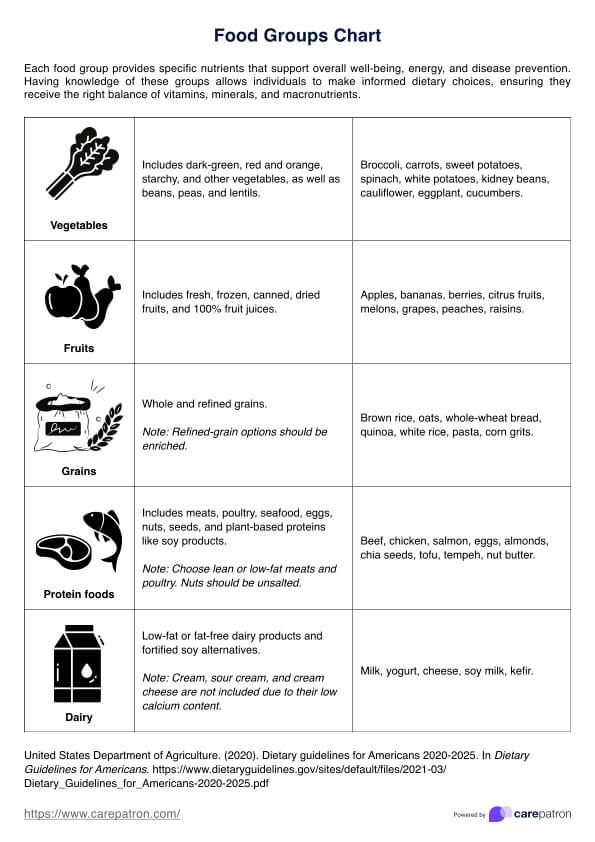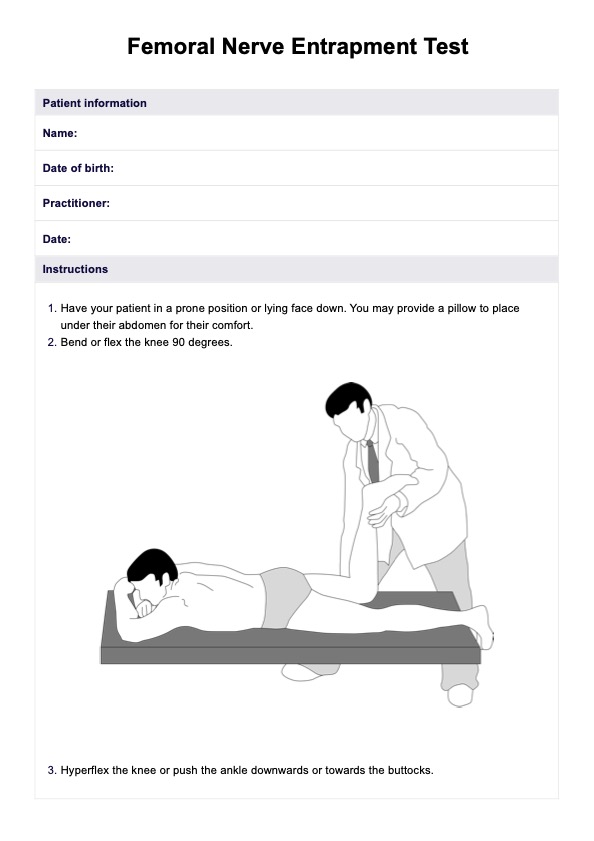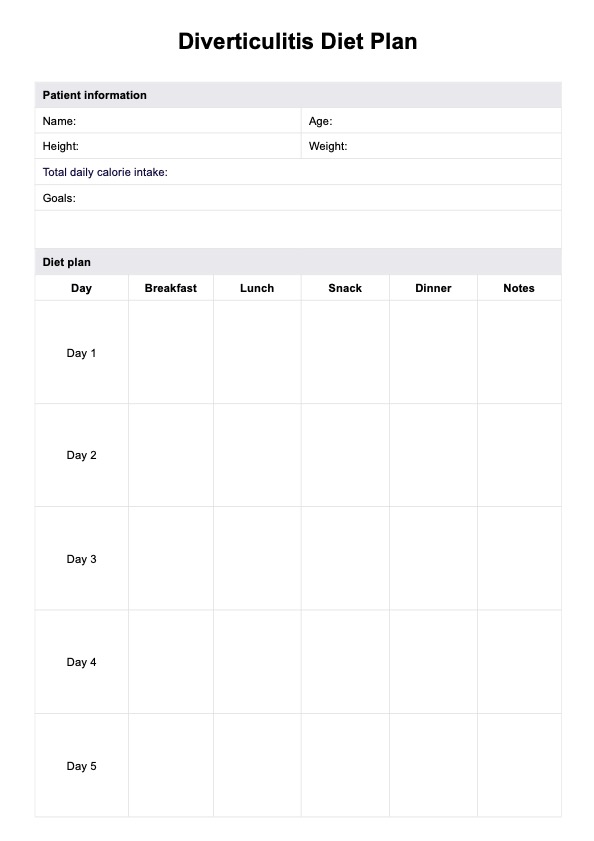Glute Muscle Diagram
Download our user-friendly Glute Muscle Diagram to help patients visualize their glute muscles and understand their role in overall health and fitness.


What is a Glute Muscle Diagram?
A Glute Muscle Diagram is a visual representation of the gluteal region muscles located posteriorly in the pelvis and encompassing the buttocks. This diagram clearly depicts vital muscles such as the gluteus maximus, gluteus medius, and gluteus minimus.
This diagram plays an essential role in injury diagnosis by allowing patients to see where a strain or tear has occurred, which helps them understand the injury and follow the recommended treatment plan. For injury treatment, therapists can use it to explain which muscles need rehabilitation or strengthening.
In strength training and bodybuilding, this diagram is an excellent reference for trainers and athletes to target specific glute muscles for growth and performance enhancement. Coaches also benefit by having a visual aid to guide their athletes through proper form and prevent injuries.
Finally, for patient education, the diagram helps simplify complex anatomy for individuals looking to improve their understanding of the glutes and their importance to overall movement.
Glute Muscle Diagram Template
Glute Muscle Diagram Example
How to use our diagram template
Our free Glute Muscle Diagram is user-friendly and fully digital. Follow these steps to use the template:
Step 1: Access the template
Get a copy of the Glute Muscle Diagram by clicking "Use Template," which opens it in the Carepatron app. From there, you can customize it, fill it, print it, or share it. You can also get a non-customizable PDF version by clicking "Download," which you can still fill digitally or print.
Step 2: Use in your practice
Use the Glute Muscle Diagram to explain gluteal anatomy and exercises to your patients. You can also use it as a reference when creating customized treatment plans for individuals with glute-related problems.
Step 3: Record findings and recommendations
The template also has sections for recording findings and recommendations, making it an excellent tool for tracking patient progress and streamlined clinical documentation. It is also helpful for patients to visually represent their condition and the recommended exercises or treatment plan.
Step 4: Share with your patients
You can email or print out the glute muscles diagram and give it to your patients as a reference for their at-home exercises. This allows them to continue their glute-strengthening regimen with proper form and technique even when not in the clinic.
When should you use this template?
The Glute Muscle Diagram Template is useful for patients with various glute-related problems. It's a handy visual aid for physical therapists and other healthcare professionals to explain the underlying issues and provide recommendations. You can use this template in the following scenarios:
When diagnosing a new patient with glute-related complaints
You can use the diagram to explain to your patient what muscles are involved and how they may contribute to their condition. This can help them better understand their diagnosis and the recommended treatment plan.
During an initial assessment
During a patient's initial evaluation, the Glute Muscle Diagram can be used to identify any muscle imbalances or weaknesses. This information can guide your treatment plan and help you track progress.
For patient education and self-care instructions
Our free template is also useful for patient education and self-care instructions. You can print or email the diagram to your patients so they have a visual reference of their condition and know what exercises or stretches to do at home.
When presenting information to other healthcare professionals
You can also use the Glute Muscle Diagram Template when presenting information to other healthcare professionals, such as during a case conference or referral. It can help you effectively communicate your findings and treatment plan to ensure the best care for your patient.
When developing a rehabilitation or fitness program
Our template can also be used when creating a rehabilitation or fitness program for patients with glute-related problems. It provides a clear visual representation of the muscles involved and their functions, which can help guide exercise selection and progression.
The glute muscles in detail
The glute muscles are one of the largest and strongest muscles in the body. They play a crucial role in movements such as walking, running, jumping, and maintaining balance. The three main muscles in this group are the gluteus maximus, gluteus medius, and gluteus minimus.
Gluteus maximus
The gluteus maximus is the largest and outermost muscle of the glutes. It plays a significant role in hip extension, supporting activities such as standing up, climbing stairs, and running. It attaches to the gluteal tuberosity of the femur and the posterior gluteal line of the ilium. The inferior gluteal nerve and the inferior gluteal arteries supply it. The sciatic nerve, located near this muscle, can sometimes become compressed, causing sciatica, a common complaint related to gluteal dysfunction.
Gluteus medius
The gluteus medius muscle lies beneath the gluteus maximus and assists with hip abduction and internal rotation. It stabilizes the pelvis during walking and standing on one leg. The superior gluteal nerve and superior gluteal arteries supply this muscle. A weak gluteus medius often leads to poor balance, hip pain, or improper posture. It originates near the anterior superior iliac spine and plays a vital role in stabilizing the lower body during movement.
Gluteus minimus
The gluteus minimus is the smallest muscle of the glutes, located underneath the gluteus medius. It works alongside the medius in abduction and internal rotation of the hip. The gluteus minimus also plays an essential role in pelvic stability and movement control. Weakness in this muscle can contribute to hip and lower back pain. Like the medius, it is supplied by the superior gluteal nerve and superior gluteal arteries.
Glute muscle functions
The gluteal muscles are essential for the movement and stability of the lower body. Specifically, the gluteus medius and minimus are crucial for hip abduction, which involves moving the thigh away from the midline. These muscles also contribute significantly to external and internal rotations of the hip (James, 2023).
In contrast, the gluteus maximus primarily functions in extending the thigh at the hip joint, serving as a powerhouse for activities such as rising from a seated position, straightening from a bending position, climbing stairs or hills, and running (Elzanie & Borger, 2023). This muscle's extension function is essential for various day-to-day movements that require forceful leg extension.
Additionally, the gluteal muscles significantly contribute to maintaining pelvic stability, effectively reducing excessive motion and rotation of the lower extremities. This stability is particularly crucial during weight-bearing activities like walking, running, or lifting weights, providing a foundation for efficient and controlled movement.
These muscles also play a role in trunk stability, especially when standing on one leg. The gluteal muscles assist in counteracting forces generated by the upper body, contributing to maintaining proper spine alignment and overall trunk stability (Elzanie & Borger, 2023). This function is fundamental for balance and coordination during various activities, preventing unnecessary stress on the spine and lower body.
Overall, the glute muscles' strength and stability are essential for everyday movements, sports performance, and injury prevention. Incorporating exercises targeting these muscles in a well-rounded fitness routine is crucial to maintain optimal function and movement. Additionally, proper form and technique during exercises targeting the gluteal muscles are key to avoiding overworking or straining these important muscle groups.
References
Buckthorpe, M., Stride, M., & Villa, F. D. (2019). Assessing and treating gluteus maximus weakness - A clinical commentary. International Journal of Sports Physical Therapy, 14(4), 655-669. PMID: 31440415; PMCID: PMC6670060. https://www.ncbi.nlm.nih.gov/pmc/articles/PMC6670060/
Elzanie, A., Borger, J. (2023). Anatomy, bony pelvis and lower limb, gluteus maximus muscle. In: StatPearls [Internet]. Treasure Island (FL): StatPearls Publishing. https://www.ncbi.nlm.nih.gov/books/NBK538193/
James, E. (2023). The ultimate glute blog: Part 1 of 2 - Glute anatomy and function. National Institute for Fitness and Sport (NIFS). https://www.nifs.org/blog/ultimate-glute-blog-part-1of-2-glute-anatomy-and-function
Commonly asked questions
Exercises like squats, lunges, and hip thrusts are some of the most effective movements for targeting the gluteal muscles, specifically the gluteus maximus and medius.
Weak glutes can manifest as poor posture, lower back pain, or knee pain, and you may experience difficulty with single-leg activities like running or balancing.
Glute muscle pain may feel like a dull ache or sharp discomfort, particularly during activities involving hip movement, such as walking, sitting, or climbing stairs.


